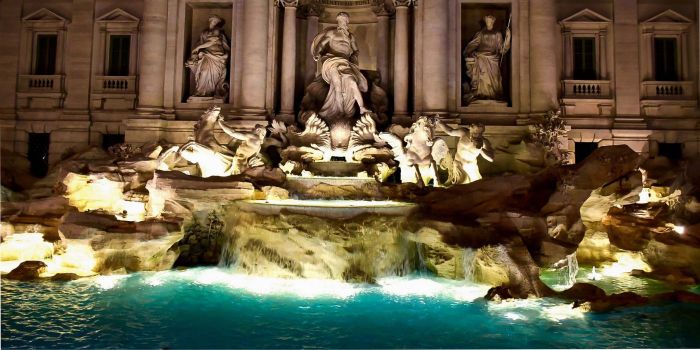Trevi Fountain: the most famous in Rome, between baroque art and good luck rituals
Trevi Fountain: the tickets most chosen by travelers
The Trevi Fountain is one of the most folkloric places in Rome, come find out why
The Trevi Fountain, one of Rome's most famous monuments, is a must-see for anyone visiting the Eternal City. With its imposing Baroque beauty and the tradition associated with coin tossing, the Fountain is not only a work of art, but also a place rich in historical and cultural significance. Get ready to learn all about this wonder of Rome!
The complex was designed by Nicola Salvi in 1732. To complete the work, however, it required the subsequent intervention of Pietro Bracci in 1759, who together with his son managed to complete the undertaking only in 1762, the official date of the Fountain's inauguration. Among Rome's fountains it is also the largest, with a width of 20 meters and a height of 26 meters.
“Protagonist” of the scene is the sea god Ocean, who drives a shell-shaped chariot drawn by two winged horses. The two animals are meant to represent two specific moments in the movements of the sea, in fact one is nicknamed the agitated horse, while the other is placid. It is not difficult to guess what they refer to.
The Fountain, located in Rome's Piazza di Trevi of the same name, owes its name to the three streets that converged toward it.
The history of this marvelous Fountain is linked to that of the so-called Aqua Virgo, a Virgin Water aqueduct that dates back as far as the time of Emperor Augustus.
The Aqua Virgo Aqueduct was built in 19 B.C. to bring water to Agrippa's baths. The water source, which today flows into the fountain, was crucially restored during the period of ancient Rome, a link that further enriches its thousand-year history.
It is not surprising, after all, that every corner of the Eternal City is marked by a history rooted in a very distant time: indeed, it is part of Rome's immortal charm.
Useful information for the Trevi Fountain
The Piazza Fontana di Trevi is a picturesque corner of Rome, where the fountain's Baroque art blends with the capital's lively atmosphere. It is the perfect meeting point to admire the monument, take photos and take a break in the surrounding cafes.
Being a monument located in a public square, there is no need to pay any ticket to see this magnificent Fountain, as well as you will have the possibility to admire it h24.
If you wish to take a guided tour, there are several options that will allow you to discover hidden secrets and curiosities.
However, since it is really one of the most popular sites in Rome, the only calculation you could make is to imagine times when there is less crowding, so that you can enjoy the view to the fullest and take all your selfies with as few “extras” as possible. An attempt can be made very early in the morning or while other tourists are busy eating the day's meals: in fact, remember that it is strictly forbidden to eat while perched around the fountain!
Other important reminders: bathing in the fountain or sitting on the edges of the facility is prohibited. Always respect the environment and other visitors to ensure a pleasant experience for all.
What are the best tours to see the Trevi Fountain
The Trevi Fountain as we mentioned, is one of the most beloved and photographed monuments in Rome. But like all famous things, there is always something new about it just waiting to be discovered, and one of these tours might be just what you've been looking for!
- Trevi Fountain Rome: Guided Tour of the Domus Sotterranee
With the help of an archaeological guide, you'll see relics from the imperial era and an ancient building complex buried nine meters below the city's modern streets. - Trevi Fountain: Underground House + Guided Walking Tour
Explore Piazza Navona, the Pantheon and discover the secrets beneath Trevi. The tour (in English) will give you a fresh look at these famous monuments. - Trevi Fountain Rome: 40-minute guided tour of the underground Domus
Discover the world's most famous fountain and what lies beneath it. - Pantheon and Trevi Fountain Rome: Guided tour of Rome's secrets.
Two of Rome's most important attractions are ready to reveal all their secrets to you with the accompaniment of an expert guide. - Piazza Navona, Pantheon and Trevi Fountain in Rome: 1 1/2-hour guided tour
A one-and-a-half-hour guided tour that will introduce you to the most interesting anecdotes about the city's most famous sites, such as the Trevi Fountain and Piazza Venezia. The tour is in English.
How to reach the Trevi Fountain
If you are traveling by train, from Termini station you can reach the Trevi Fountain by cab or by taking the Metro line A (direction Battistini). The stop is Piazza Barberini and with only a 5-minute walk you will be in front of the Fountain.
An alternative method of reaching the Fountain is to take the bus. Always leaving from Termini, about 200 meters away is the De Nicola/Termini stop from which line 85 runs every 7 minutes. When you get off at the San Claudio stop, you will be 50 meters from Via del Tritone.
If you are arriving by plane, however, you could use the Terravision shuttle bus or the Leonardo Express train, which takes you to Termini Station.
The best experiences in Rome
Best attractions around Trevi Fountain
all entrance tickets for the most popular Italian attractions
St.Peter's Basilica
RomeColosseum
RomeVatican Museum
RomePantheon
RomeSistine Chapel
RomeSant'Angelo Castle
RomeTivoli Villas
RomeBorghese Gallery
RomeTrevi Fountain underground: discovering the City of Water
The world's most famous fountain hides a beautiful secret underneath. Discover the City of Water by visiting Trevi Fountain Underground.
Read more
Frequently asked questions about the Trevi Fountain
1. What does the Trevi Fountain symbolize?
The fountain is universally recognized as a symbol of prosperity and good fortune.
2. Is the fountain illuminated all night long?
Yes, the Fountain is always illuminated.
3. What material was the Fountain built with?
The material used for the fountain is called travertine, which comes from Latin and means “from the Tiber.” Travertine is a mineral composed of calcium carbonate, the origin of which can be found in spring waters.
4. What statues are found in the Trevi Fountain?
In the center of the composition we find the statue of the god Ocean, while at the sides are placed the statues of Salubrity and Abundance by Filippo Della Valle. At the top, on the other hand, we find the Abundance of Fruit by Agostino Corsini, the Fertility of the Fields by Bernardo Ludovisi, the Gifts of Autumn by Francesco Queirolo, and the Amenity of the Meadows by Bartolomeo Pincellotti.
5. What does the god Ocean represent in the Trevi Fountain?
The god Ocean, in the center of the fountain, represents the sea, a fundamental element in the life of ancient Rome, a symbol of power and control over water. The winged horses symbolize the instability and calm of the sea.
6. What is inside the Trevi Fountain?
The Trevi Fountain is one of the most iconic fountains in the world, but it contains no special objects inside. The water that flows in the fountain comes from the Aqua Virgo Aqueduct. However, there are historic underground vaults beneath the square that contain Roman remains, which can be visited during archaeological tours.
7. When does the Trevi Fountain reopen?
The Trevi Fountain is generally open to the public without interruption. However, it may be temporarily closed for restoration work, as has happened in the past. Always check the official website or local information channels for up-to-date information on any closures.
8. What building is behind the Trevi Fountain?
Behind the Fountain is the Palazzo Poli, an imposing building overlooking the square that also houses the Academy of Fine Arts. The palace contributes to the extraordinary setting that frames the fountain.
9. How much money is collected by the Trevi Fountain?
Each year, coins tossed into the Trevi Fountain amount to several thousand euros, which are then used for charitable purposes.
What to do nearby Trevi Fountain
Once you've flipped your coin, you might consider visiting the other attractions near the Trevi Fountain.
Start with Piazza di Spagna where you will see the world-famous monumental Spanish Steps of Trinità dei Monti. This is also a renowned area for shopping, surely a tour is a must.
How can you not then dedicate some of your time to a visit to the Pantheon, a wonderful temple of ancient Rome that will leave you completely enchanted. Still in the immediate vicinity of the Fountain is Piazza Venezia with one of Italy's symbolic monuments: the Vittoriano, often called the "Altare della Patria". This work dedicated to Victor Emmanuel II was designed by architect Giuseppe Sacconi.
The Trevi fountain in popular culture
The most famous tradition associated with the Trevi Fountain is surely that of the coin toss, made famous by Jean Negulesco's 1954 film Three Coins in the Fountain.
Perhaps not everyone knows that, depending on the number of coins tossed, the outcome will change: with one you will be sure to return to Rome, with two you will find love with an Italian, with three you will end up marrying the person you met.
But perhaps it is another film that made this Fountain iconic with the scene in which the beautiful Anita Ekberg bathes in its waters, in the masterpiece La dolce Vita. But you don't imitate it, if you don't want to take with you an unwelcome souvenir like a hefty fine.
In any case, the coin should not just be tossed but some sort of etiquette should be followed. Turning your back to the fountain, you must toss with your right hand over your left shoulder. The good news is that regardless of whether it brings you luck or not, all coins tossed into the Fountain are collected and donated to charity Caritas.













Chiara Spaziano
An unmissable stop in the Eternal City, the Trevi Fountain is waiting to be the backdrop for your most beautiful memorable photos.